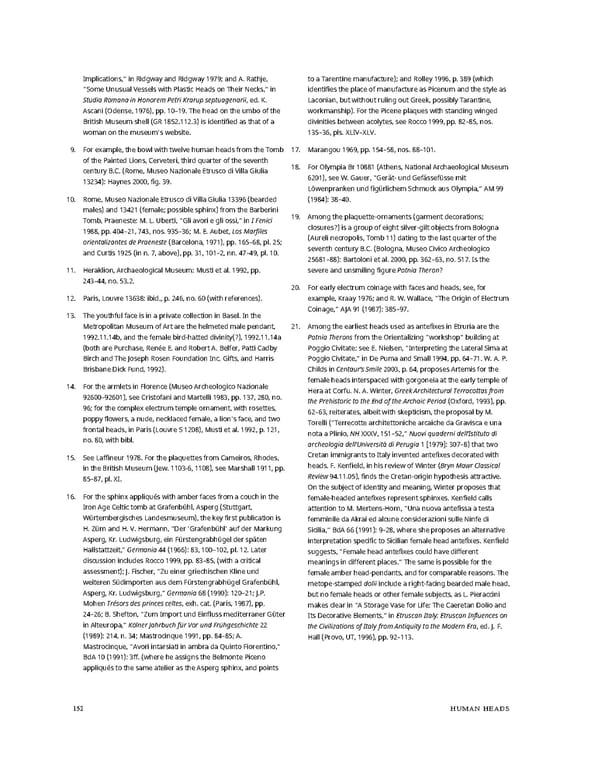Implications,” in Ridgway and Ridgway 1979; and A. Rathje, to a Tarentine manufacture); and Rolley 1996, p. 389 (which “Some Unusual Vessels with Plastic Heads on Their Necks,” in identifies the place of manufacture as Picenum and the style as Studia Romana in Honorem Petri Krarup septuagenarii, ed. K. Laconian, but without ruling out Greek, possibly Tarantine, Ascani (Odense, 1976), pp. 10–19. The head on the umbo of the workmanship). For the Picene plaques with standing winged British Museum shell (GR 1852.112.3) is identified as that of a divinities between acolytes, see Rocco 1999, pp. 82–85, nos. woman on the museum’s website. 135–36, pls. XLIV–XLV. 9. For example, the bowl with twelve human heads from the Tomb 17. Marangou 1969, pp. 154–58, nos. 88–101. of the Painted Lions, Cerveteri, third quarter of the seventh 18. For Olympia Br 10881 (Athens, National Archaeological Museum century B.C. (Rome, Museo Nazionale Etrusco di Villa Giulia 6201), see W. Gauer, “Gerät- und Gefässefüsse mit 13234): Haynes 2000, fig. 39. Löwenpranken und figürlichem Schmuck aus Olympia,” AM99 10. Rome, Museo Nazionale Etrusco di Villa Giulia 13396 (bearded (1984): 38–40. males) and 13421 (female; possible sphinx) from the Barberini 19. Among the plaquette-ornaments (garment decorations; Tomb, Praeneste: M. L. Uberti, “Gli avori e gli ossi,” in I Fenici closures?) is a group of eight silver-gilt objects from Bologna 1988, pp. 404–21, 743, nos. 935–36; M. E. Aubet, Los Marfiles (Aureli necropolis, Tomb 11) dating to the last quarter of the orientalizantes de Praeneste (Barcelona, 1971), pp. 165–68, pl. 25; seventh century B.C. (Bologna, Museo Civico Archeologico and Curtis 1925 (in n. 7, above), pp. 31, 101–2, nn. 47–49, pl. 10. 25681–88): Bartoloni et al. 2000, pp. 362–63, no. 517. Is the 11. Heraklion, Archaeological Museum: Musti et al. 1992, pp. severe and unsmiling figure Potnia Theron? 243–44, no. 53.2. 20. For early electrum coinage with faces and heads, see, for 12. Paris, Louvre 13638: ibid., p. 246, no. 60 (with references). example,Kraay 1976; and R. W. Wallace, “The Origin of Electrum 13. The youthful face is in a private collection in Basel. In the Coinage,” AJA 91 (1987): 385–97. Metropolitan Museum of Art are the helmeted male pendant, 21. Among the earliest heads used as antefixes in Etruria are the 1992.11.14b, and the female bird-hatted divinity(?), 1992.11.14a Potnia Therons from the Orientalizing “workshop” building at (both are Purchase, Renée E. and Robert A. Belfer, Patti Cadby Poggio Civitate: see E. Nielsen, “Interpreting the Lateral Sima at Birch and The Joseph Rosen Foundation Inc. Gifts, and Harris Poggio Civitate,” in De Puma and Small 1994, pp. 64–71. W. A. P. Brisbane Dick Fund, 1992). Childs in Centaur’s Smile 2003, p. 64, proposes Artemis for the 14. For the armlets in Florence (Museo Archeologico Nazionale female heads interspaced with gorgoneia at the early temple of 92600–92601), see Cristofani and Martelli 1983, pp. 137, 280, no. Hera at Corfu. N. A. Winter, Greek Architectural Terracottas from 96; for the complex electrum temple ornament, with rosettes, the Prehistoric to the End of the Archaic Period (Oxford, 1993), pp. poppy flowers, a nude, necklaced female, a lion’s face, and two 62–63, reiterates, albeit with skepticism, the proposal by M. frontal heads, in Paris (Louvre S 1208), Musti et al. 1992, p. 121, Torelli (“Terrecotte architettoniche arcaiche da Gravisca e una no. 80, with bibl. nota a Plinio, NH XXXV, 151–52,” Nuovi quaderni dell’Istituto di archeologia dell’Università di Perugia 1 [1979]: 307–8) that two 15. SeeLaffineur 1978. For the plaquettes from Cameiros, Rhodes, Cretan immigrants to Italy invented antefixes decorated with in the British Museum (Jew. 1103-6, 1108), see Marshall 1911, pp. heads. F. Kenfield, in his review of Winter (Bryn Mawr Classical 85–87, pl. XI. Review 94.11.05), finds the Cretan-origin hypothesis attractive. On the subject of identity and meaning, Winter proposes that 16. For the sphinx appliqués with amber faces from a couch in the female-headed antefixes represent sphinxes. Kenfield calls Iron Age Celtic tomb at Grafenbühl, Asperg (Stuttgart, attention to M. Mertens-Horn, “Una nuova antefissa a testa Würtembergisches Landesmuseum), the key first publication is femminile da Akrai ed alcune considerazioni sulle Ninfe di H. Zürn and H. V. Hermann, “Der ‘Grafenbühl’ auf der Markung Sicilia,” BdA 66 (1991): 9–28, where she proposes an alternative Asperg, Kr. Ludwigsburg, ein Fürstengrabhügel der späten interpretation specific to Sicilian female head antefixes. Kenfield Hallstattzeit,” Germania 44 (1966): 83, 100–102, pl. 12. Later suggests, “Female head antefixes could have different discussion includes Rocco 1999, pp. 83–85, (with a critical meanings in different places.” The same is possible for the assessment); J. Fischer, “Zu einer griechischen Kline und female amber head-pendants, and for comparable reasons. The weiteren Südimporten aus dem Fürstengrabhügel Grafenbühl, metope-stampeddoliiinclude a right-facing bearded male head, Asperg, Kr. Ludwigsburg,” Germania 68 (1990): 120–21; J.P. but no female heads or other female subjects, as L. Pieraccini MohenTrésors des princes celtes, exh. cat. (Paris, 1987), pp. makes clear in “A Storage Vase for Life: The Caeretan Dolio and 24–26; B. Shefton, “Zum Import und Einfluss mediterraner Güter Its Decorative Elements,” in Etruscan Italy: Etruscan Influences on in Alteuropa,” Kölner Jahrbuch für Vor und Frühgeschichte 22 the Civilizations of Italy from Antiquity to the Modern Era, ed. J. F. (1989): 214, n. 34; Mastrocinque 1991, pp. 84–85; A. Hall (Provo, UT, 1996), pp. 92–113. Mastrocinque, “Avori intarsiati in ambra da Quinto Fiorentino,” BdA10 (1991): 3ff. (where he assigns the Belmonte Piceno appliqués to the same atelier as the Asperg sphinx, and points 152 HUMAN HEADS
 Ancient Carved Ambers in the J. Paul Getty Museum Page 161 Page 163
Ancient Carved Ambers in the J. Paul Getty Museum Page 161 Page 163